One-Pass Assembler
- Need for an Assembler
- Computers cannot directly execute assembly language instructions; they require machine-readable object code.
- Assemblers are used to convert human-readable assembly code into object code that can be executed by the machine.
- A one-pass assembler is more efficient than a two-pass assembler, since it builds the symbol table and generates object code simultaneously.
- Handling forward references (symbols used before being defined) is one of the major challenges in one-pass assembly.

- About the project
- Implemented in C++ as part of a System Programming assignment.
- Uses an OPTAB (Opcode Table) to map assembly mnemonics to machine opcodes.
- Builds a SYMTAB (Symbol Table) to manage labels and addresses dynamically.
- Handles forward references using backpatching techniques.
- Supports assembler directives such as
WORD,BYTE,RESB,RESW. - Generates object program records in the standard format:
- Header Record (H)
- Text Records (T)
- End Record (E)
Read more about project on github.
